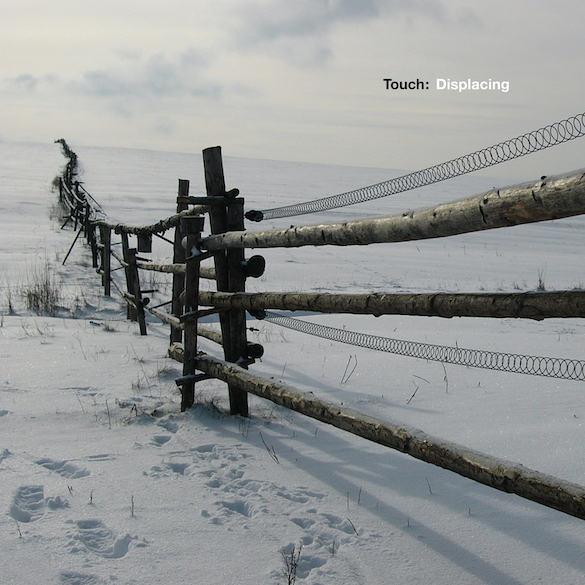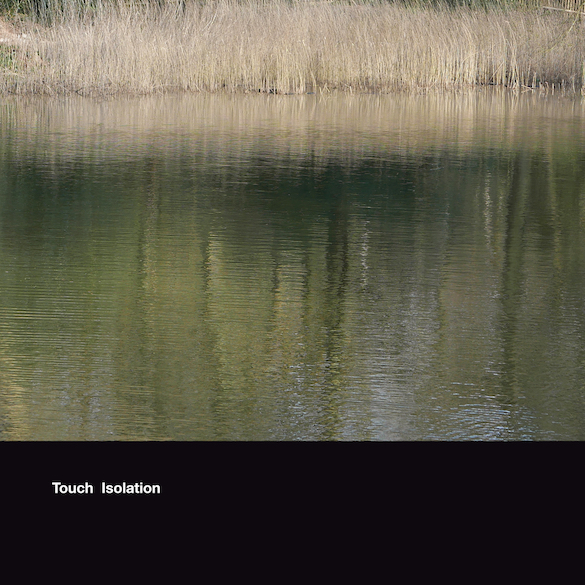CD – 3 Tracks – 50:09
Chris Watson writes:
“During December 2000 several significant storm fronts developed across the North Sea and Scandinavia.
Benny remarked to me that he had recorded some of these on the Baltic coast and proposed a collaborative cd project based around our mutual interests in the rhythms and music created when the elements combine over land and out to sea.
We spent the next few years gathering recordings on our respective coastlines and islands during the very active weather windows during the autumnal equinox and winter solstice. This was focused around our following one particular cyclonic system, which veers over Snipe Point on Lindisfarne to the Isle of May in the Firth of Forth, and finally descends upon Öland and Gotland where Benny listened in with a favourite pair of Sennheiser omnidirectional microphones.”
Chris Watson
Newcastle upon Tyne August 2006
Track list:
1. Chris Watson – No Man’s Land 15:51
Late October on the strands of Budle Bay where dense layers of transient alien voices are swamped by a full moon tide creeping across the island’s silver causeway.
Now lapping out of the gathering gloom an immersive sea wash is filling then draining away carrying slow currents from here to another place.
There are no reference points in this darkness.
Glimmer dawn in the gaping mouth of a sea cave below Tarbet Gulley where the siren songs of Cromarty, Forth & Tyne ebb and flow with the swell.
Draw in close but hear now a fresh voice from beyond the horizon.
Recorded during the months of October & November from 2000 to 2005 on the North East coast of England and Scotland. Microphones; Sennheiser 2 x MKH 110’s binaural pair, MKH 60/30 M&S rig, DPA 2 x 4060’s spaced omnis. Recorders; Nagra lV-S, Nagra Pll and Sound Devices 744T. Edited and Mixed in Boston July 2006
2. BJNilsen & Chris Watson – SIGWX 18:50
Viking, Forties; Cyclonic North East gale 8 backing North later 3 to 4.Thundery rain, moderate to good.
Mixed in Boston and Stockholm June & July 2006
3. BJNilsen – Austrvegr 15:28
A black ruthless sea. Heavy winds making it impossible to stand up straight, icy rain hitting your face like needles.
Recorded on the southeast coast of islands Gotland and Öland, Sweden, using a pair of Sennheiser 110 binaural mics straight to a Tascam DA P1 DAT during December 2003 and July 2004. Locations used included cottages, sheds, barns, fields and the coast. Edited and Mixed in Stockholm 2006
Reviews:
Storm was nominated for a Qwartz Award in the Qwartz Experimental/Research category 2007
London Milk (UK):
Back in 2000, Swedish musician recorded a series of storms over the Baltic sea, and consequently suggested that him and fellow Touch sound artist Chris Watson collaborate on a project focusing on weather conditions.
Watson, once of pioneering electronic outfit Cabaret Voltaire and, later, of The Hafler Trio, is an established wildlife recordist, who has, beside his three albums for Touch, worked for the Royal Society for the Protection of Birds and recorded nature for a variety of wildlife programs for the BBC. After a few years away from the music scene, he returned in 1996 with his first solo album for Touch, Stepping Into The Dark, which was built from recordings he had made all around the world during previous years.
Stockholm-based Benny Jonas Nilsen first emerged in the early nineties under the pseudonym of Morthond (later Morthound), with his debut album, The Crying Age, published on Swedish imprint Cold Meat Industry when he was just fifteen. Nilsen reinvented himself as Hazard in the mid nineties and released a handful of ambient records for Malignant, Ash International and Touch, before eventually publishing music under his own name.
Storm features three extended tracks, with Watson claiming No Man’s Land, which opens, and Nilsen Austrveg, which closes the album, the pair collaborating on the middle track, SIGWX. The two solo tracks span just over fifteen minutes each while the middle piece clocks in at just under nineteen minutes. Each piece is based on a series of recordings made on the artists’ respective coastlines and documenting everything from wildlife (especially in Watson’s piece) to sea conditions, wind and storms.
Watson’s recordings were made on the North East coast of England and Scotland, during October and November, between 2000 and 2005 and present a rather active series of soundscapes, with vast colonies of sea birds drowned in an increasing cacophony as they get more agitated, rough seas and animal noises. The latter bring an organic, almost human, dimension to the piece, especially in the second half when Watson introduces recordings made in a cave.
Nilsen’s piece is built from recordings made on Gotland and Öland, two neighbouring islands situated in the South East of Sweden. Here, Nilsen focuses primarily on the evolution of weather patterns and the impact it has on his environment. As sounds of waves breaking on the shores, strong winds and rain appear to constantly battle for supremacy, an underlying rhythmic pattern slowly emerges, with organic loops spreading over several minutes as the elements take it in turn to dominate.
Taking its name from a weather forecast term indicating significant weather, SIGWX sees Watson and Nilsen bring their respective recordings together and confront their findings, from various life forms to evolving weather patterns and environmental noises. Watson’s meticulous formations provide a rich backdrop for Nilsen’s more exposed recordings, resulting in an exceedingly dense and dramatic piece.
Despite the apparent simplicity of this record, Watson and Nilsen present here an incredibly detailed and vibrant document, which not only charts landscapes and weather conditions, but also captures a myriad of particles of wildlife and places them in a very particular context. These three sequences are extremely vivid and realistic, leaving the listener to wonder whether they may be experiencing these for real.
BBCi (UK):
Chris Watson’s field recordings of wildlife and natural phenomena pose a lot of questions; is this music? if not, what are we listening to? should this flock of geese be getting royalties? With his more recent work Watson has bucked a few of those questions by mixing, editing and collaging his material into soundscapes that are more akin to music than anything else.
That’s very much the case here. Nilsen (aka Hazard and a purveyor of minimal electronics) and Watson have collaborated before, most notably on Hazard’s Wind. They share an interest is in the ‘rhythms and music’ of the elements, and these recordings follow a particular cyclonic system that visits North East England, Scotland and Sweden.
The opening “No Man’s Land” is a tour de force; assembled and collaged by Watson from several recordings made over a five year period, it takes the listener on a strange and improbable journey; a coastal walk in worsening weather where seabirds gather in their masses and seals moan spookily to themselves. At one point the mounting roar and hiss of the storm engulfs everything; there’s a brief moment when it feels like Watson’s microphones are under the water. At the finish I was expecting to open my eyes and find the living room overrun with seaweed, driftwood and maybe a flock of stormy petrels…
‘SIGWX’ takes a similar approach and achieves similar levels of intensity and abstraction, but in a way the most effective piece is Nilsen’s closing “Austrvegr”. Recorded in on the islands of Gotland and Oland, it offers the grim monotony of wind and rain, heard from various cottages, sheds, fields and beaches. It’s a meditative, strange experience, and comes highly recommended. [Peter Marsh]
The Sound Projector (UK):

Record Collector (UK):
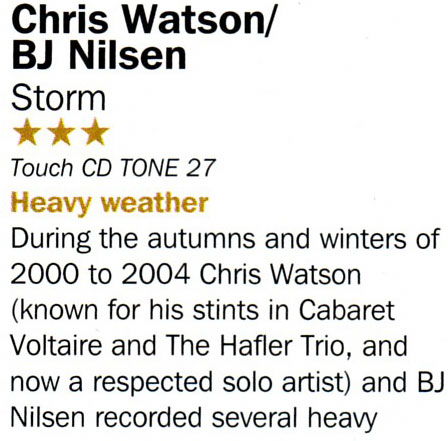
Baltimore City Paper (USA):
As a sound recordist for institutions like the BBC as well as a string of solo releases, former Cabaret Voltaire member Chris Watson has set up his equipment everywhere from British parliament to African veldts. (Sometimes in quick succession: He quipped to The Wire magazine that he once used a mic on a politician that still had dried zebra blood and gunk on it.) Storm, this year’s collaboration with fellow microphone fiend BJ Nilsen, moves from the earth into the air, capturing the weather on the coasts of England and Scotland between 2000 and 2005. If the idea of “listening to the weather” sounds like something you could do any time – and for free – Watson and Nilsen’s high-tech acoustic phenomenon-capturing devices turn wind and rain and non-silent silences into an abstract-expressionist sonic movie as gripping as any recording you’ve heard this year. [Jess Harvell]
Boomkat (UK):
It’s always an event when a new Chris Watson disc comes into view from the distance. The lauded field recording expert has become widely regarded as the best in his field having recorded three solo discs for Touch since 1996 showing the breadth of his style. He doesn’t do anything more than record locations and atmosphere, but if you thought field recording was merely birds tweeting and wind blowing prepare to be astounded, as Watson amplifies sounds you didn’t even realise were there, contextualizing nature as experimental music perfectly. This time around Watson appears with his friend and fellow Touch recording artist BJ Nilsen and the story goes that Nilsen called up Watson to express his interest in a series of storms across the North Sea. Nilsen had been recording them and had been quite stunned by the results, and proposed a collaborative cd project with Watson to explore these natural rhythms and music created by storms at sea. And what a collaboration the two have managed, this disc despite its apparently simple means is as detailed and as absorbing as any collection of supposedly textured experimental music you could possibly find this year with waves of noise so detailed and so organic that when you think about it they could only really come from the organic world. The sound of rain gets lost in crashing waves and wind batters both into submission, rocks are avoided or smashed into purposefully and water rises and falls with unmatched aggression. This is a symphony of the skies, and simply must be heard to be believed whether it is Watson’s shockingly detailed track recorded on the North East coast of England and Scotland, Nilsen’s more stripped down recordings on two Swedish islands or their collaborative track – each takes us on an intense journey into the very nature of sound, and the sound of nature. Essential….
The Wire (UK):
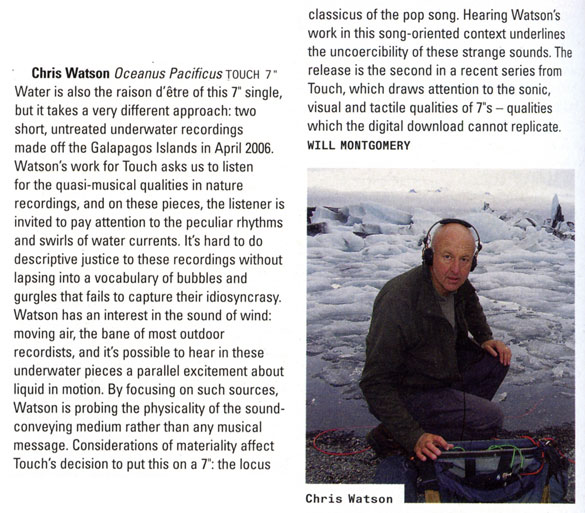
Bad Alchemy (Germany):
Schon die ersten Töne von Storm (Tone 27) lassen einen zusammenzucken vor der schrillen Kakophonie von Tausenden von Seevögeln, den natürlichen Bewohnern einer sturmumbrausten Unwirtlichkeit. CHRIS WATSON hat seine Mikrophone mitten in diesem ’No Man’s Land’ an der Küste von Northumberland aufgebaut, so dass man nun Teil hat an der Welt der Windsbräute und Sturmvögel, dem Brüllen der Brandung und dem Gefauch der Lüfte. Extrem plastisch lecken die Wasserzungen an den Felsen und verschluckt der Meeresschlund sich selbst. Dann fährt Luftgebraus in dieses Grenzgebiet aus Wasser und Stein, lässt die Brandung donnernd aufrauschen und die Gischt zischen. Kaum flaut der Sturm ab, werden ganz merkwürdige Laute hörbar, ein Stöhnen, Muhen und halb ersticktes Heulen. Weiß der Himmel, ob das nun bloß Seehunde oder Kegelrobben sind oder etwas, das man besser nicht erblickt. Der Wind frischt wieder auf und nimmt den gespenstischen Chor in sich auf. Das st die Wilde Jagd im Original. BJ NILSEN richtete für ’Austrvegr’ seine Sennheiser-Mikrophone in Gotland und Öland auf Wind und Wellen. Die Baltische See ist aufgewühlt von einem eisigen Sturm, der einen mit Nadel überschüttet und in die Knie zwingt. Nilsen duckt sich in Scheunen und Schuppen, bis das Schlimmste vorüber ist und der Strand wieder in seiner plätschernden Routine hörbar wird. Aber der Sturm flackert noch, zerrt an den Membranen und gießt ganze Schiffsladungen von Hagelkörnern über die Dächer. Molekulare Schauer, die einen noch im Wohnzimmer unbehaglich stimmen. Für ’SIGWX’ mischten die beiden Fieldrecorder dann ihre Aufnahmen. Östlich der Shetlandinseln, in den Nordseegebieten Viking und Forties, braut sich ein Nordoststurm der Windstärke 8 zusammen und zieht dann, abflauend auf 3 – 4, nach Norden ab. Ein kräftiger Gewitterregen überschüttet die Lauscher mit seinem Brausen und Grollen, die sich zu Harsh Noise verdichten. Wem diese Schizophonie mitten ins Hirn bläst, dem kommen Zweifel, ob ’da draußen’ die Natur nicht doch macht, was sie will.
VITAL (Netherlands):
Of these three new releases out of the Touch imperium (although Ash International should be seen as a separate entity, the ties are pretty strong), two of them deal with field recordings. Of all field recordings that are to be made ‘out there’ that storms and rain are the ones that are most ‘easy’, since they produce a lot of sound. Not entirely true, this somewhat bold statement, because it takes some to make a good recording of a nice storm, that sounds like a storm and not a bunch of tape hiss. If you leave the microphones to people such as Chris Watson or BJNilsen, you know there are in good hands. They both love a good storm, and have gathered a bunch of interesting recordings in that area. One storm was followed by Watson (in Newcastle) and Nilsen (on Öland and Gotland) and became a collaborate piece of music. Also each of them has a solo piece, composed out of storm sounds. In Watson’s solo piece there is a heavy storm, lots of seagulls (probably other birds as well, but I’m not the ornithologist at hand), which goes through various stages, using the different acoustics of the various places which were used to make the recordings. In their collaborative piece things are rather more subdued and calm, strangely enough and only towards the end things get louder and meaner. In BJ Nilsen’s solo piece, various recordings from various places are melted together, in order to make a strong piece of storm sounds. All three piece may sound relatively ‘easily made’, but there are not. They are highly imaginative pieces of natural sounds, and should appeal to fans of Eric LaCasa as well as others who use recordings like this to create powerful music, again like this. [FdeW]
Schlendrian (Germany):
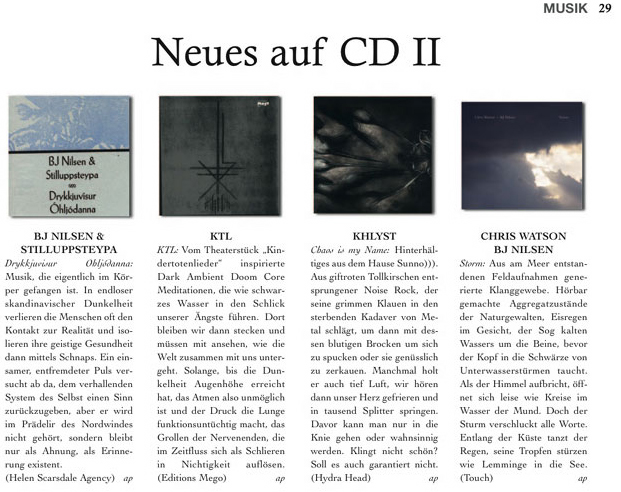
Radio France (France):
C’est dans la même famille, celle de l’artisanat discographique (sur le label Touch) que je vous propose de retrouver une autre ¦uvre en rapport avec les grands espaces désertiques, ceci autour de Benny Nilsen et de Chris Watson. Benny Nilsen a toujours été fasciné par le travail d’enregistrements d’espaces naturels réalisés par Chris Watson. Après avoir lui même enregistré quelques tempêtes en Scandinavie, il lui a proposé d’unir leurs enregistrements réalisés sur les côtes de la mer du nord en Angleterre et en Ecosse par Watson et sur deux îles suédoises par Benny Nielsen. Le résultat est à la hauteur de la réputation, de la compétence et du talent des deux preneurs de sons mais surtout donne à entendre une véritable symphonie musicale naturelle. Le vent en bourrasques, la pluie qui se fond dans le vacarme des vagues et les oiseaux massés sur les rochers, tout semble comme orchestré avec précision dans une complexité et une richesse sonore savamment mise en espace par Watson et Nielsen. Les sonorités lointaines et proches sont mixées dans un parfait équilibre et donnent naissance à un paysage musical d’une saisissante réalité.” [Eric Serva]
Other Music (USA):
The holidays are upon us and if for some reason you’d like to make someone on your list exceedingly anxious, then by all means, gift them a copy of Storm. Chris Watson and BJ Nilsen collaborate here by capturing field recordings on either side of their respective seas (Watson along the Eastern coast of England, Nilsen stationed on a beach in Western Sweden) during a particularly powerful storm system that pounded both regions in late 2000, and other ancillary events from the years to follow. Nothing has been processed here, though some editing likely took place, leaving the enormity of nature to descend upon the microphones and recorders. Flocks of geese squawk at one another, panicked, before escaping to a less hostile environment. Sea lions howl dolefully in the duress of the situation. Storm clouds roll in, bringing atmospheric disturbance, heavy rains, high winds, and with no visual markers, this all makes for an extremely unsettling listen. Throw this on your iPod; when faced with some bearded, bespectacled gentleman explaining to you how “sick” Sunn 0))) is, explain to him that you’re listening to a fierce storm that someone likely died in as it was being recorded. That’ll shut him up. [DM]
Blow Up (Italy):

Svenska Dagbladet (Sweden):
Ur stormar skapar britten Chris Watson (en gång medlem i bandet Cabaret Voltaire och nu en mästare i att spela in natur- och atmosfäriska ljud för både BBC och skivor) och svenske BJ Nilsen praktfulla ljudliga kompositioner. Med stor omsorg lyfter Watson fram såväl detaljer som kraft ut naturens symfoni från kusten längs nordöstra Storbritannien. Nilsens komposition är betydligt kargare med inspelningar från Öland och Gotland. Det är så storslaget äkta att även övriga sinnen, förutom hörseln, luras att delta. [Magnus Olsson]
Triggerfish (Germany):
Ein Tag am Meer
CHRIS WATSON und BJ NILSEN haben beide schon einge Jahre in der Welt der randständigen Klänge verbracht. WATSON als ehemaliges Cabaret Voltaire Mitglied sogar noch einige mehr als NILSEN, der erstmal, gerade der Pubertät entwachsen, Anfang der 90er mit seinem Morthound Projekt von sich reden machte.
Für “Storm” haben die beiden je einen Solotrack sowie eine Kollaboration abgeliefert, welche sich allesamt mit den Themen Meer und Sturm auseinandersetzen. Ganz semi-akademischen Arbeitsmethoden verpflichtet listen WATSON & NILSEN akribisch Mikrophon- und Rekordertypen auf, ohne diesen akustischen Ausflug an die stürmische See zu einer rein technischen Übung werden zu lassen. Die sehr dezent editieren Aufnahmen leben nicht vom schnellen Schnitt oder gewagten Effekten, sondern einzig und alleine von der puren Schönheit der Natur und seinen Gewalten. Man hört das Meer, Möven krähen, Sturm zieht auf – und irgendwo am Strand stehen die Herren Klangforscher mit ihren Aufnahmegeräten. Unbewertbar schön. [Sascha Bertoncin]
Octopus (France):
Chris Watson et BJ Nilsen ont deux point communs. Le premier est qu’ils développent tous deux des travaux sonores environnementaux où les éléments naturels occupent le plus souvent une place de premier plan. Le deuxième est qu’ils vivent aussi tous deux sur le front de mer, sur des côtes déchiquetées, balayés par les tempêtes d’équinoxe et de solstice. De la mer du Nord à la côte balte, Storm réunit donc trois pièces dantesques où les différents éléments (la mer, les oiseaux, le vent) se relayent pour entretenir vivace une agitation débordante et les fils d’un étonnant dialogue. Les brefs moments d’accalmie offrent d’étranges échanges ornithologiques. Sur “No Man’s Land”, on est convié avec une proximité sidérante, à des conversations de volatiles que l’on imagine balancés par le ressac sur les vagues à flanc de falaises, profitant du passage de l’¦il du cyclone pour rassembler les membres dispersés de la colonie. Sur l’intro de “SIGWX”, des sonorités rauques ressemblant à celles de phoques se font sourdement entendre tandis qu’à l’horizon le bruit de l’orage se rapproche, offrant un contraste saisissant entre la précarité d’un instant de plénitude déclinant face à l’inexorabilité du danger. Dans “Austrvegr”, la tempête s’installe, mais là c’est avec différents abris utilisés par les deux preneurs de sons que le dialogue se noue. Derrière les murs d’un cottage, sous la frondaison d’abris de fortune, la force de la pluie qui s’abat, du vent qui tournoie offrent de nouvelles échappées tumultueuses à cette odyssée sonore à la brutalité tactile. [Laurent Catala]
De:bug (Germany):

Sound of Music (Sweden):
Att spela in ljud är en av mina äldsta drömmar. Samla på naturens musik, stadsbuller och allt däremellan. Någon gång ska det projektet ta fart. Och med ett ökat intresse de senaste åren för skivor med fältinspelningar kan man sitta hemma i fåtöljen och lyssna på ljud från vitt skilda miljöer. Ibland blir det lättköpt när musiker som knep för att skapa en speciell stämning bakar in fågelkvitter, avlägsna röster och andra ickemusikaliska inslag. Men ofta tycker jag att det tillför någonting, det finns så många intressanta ljud, så mycket musik i tingen.
I en Invisible Jukebox-intervju i The Wire för något år sedan uttryckte Chris Watson (en gång i tiden medlem i Cabaret Voltaire) stark skepsis mot musiker och artister som jobbar på det här sättet. Han är bara intresserad av rena naturljud. Hårda ord kan tyckas, men om man lyssnar på Chris Watsons album med fältinspelningar på Touch är det lätt att förstå åsikten. Det är fantastiska skivor. Nedslag på olika platser, många i samband med BBC-produktioner, med en strävan att verkligen fånga en plats, en händelse, från naturens mångskiftande värld.
De rena, naturliga, ljuden rymmer myriader av färger, stämningar. I de tre långa spåren på Chris Watsons förra skiva, ”Weather Report”, kommer ett begrepp som kompositioner in i bilden. Parallellerna med skapade musikstycken är tydlig. Samma känsla får jag av ”No Man´s Land” som inleder Chris Watson och BJ Nilsens skiva ”Storm”. Inspelningar från Storbritanniens nordöstra kust höstmånaderna oktober och november 2000 –2005 som klippts ihop. Detsamma gäller Nilsens bidrag ”Austrvegr” (inspelningar från Gotland och Öland) och ett tredje gemensamt stycke. Arbetet startade med att Nilsen spelade in stormar och föreslog ett gemensamt cd-projekt ”based around our mutual interests in the rhythms and music created when the elements combine over land and out to sea”, som Watson skriver på konvolutet.
Ingenmansland. Sjöfåglarnas rike. Vinden stegrar. Vattnet attackerar klipporna. Mikrofonerna närmar sig skummet, rytmerna i vattnets möte med det annalkande ovädret är i ständig förändring. Uppstigande och nedstigande, det är en fysisk upplevelse att lyssna. Efter nio minuter ungefär är det en annan akustik, ett kort tag låter det som man har hamnat i en undervattensgrotta. Fnys-, pip- och knorrljud tar vid. Frustande sälar? Valross? Eller stora fåglar. En albatrossfamilj? Det blåser mer och mer. Sjöfåglarna återkommer, cirkelrörelser, jag kan knappt simma, rädslan, respekten för havet. Strandområden. Klipporna. Människans frånvaro. Chris Watsons mikrofoner registrerar, dokumenterar, berättar. Ickemusik som är musik.
BJ Nilsens stormkomposition förflyttar oss till Östersjön. Jag fryser när jag skriver. Jag fryser när jag lyssnar. Mycket avlägsna fåglar vid något tillfälle. Vinden och vattnet i ett mäktigt samspel. Samtidigt vill jag vara där, stå i varma kläder och lyssna på rytmerna. Är det natt? Det känns så. Åtminstone när det blåser hårt och skoningslöst. Vattenskvalpet en bit efter mitten har en mer melodisk klang. En lugnande effekt. Senare ljud studsar mot föremål. Trädgrenar kanske, något fladdrar, inspelat i ett tält? Rinnande vatten nära mikrofonerna. Små och stora element.
Det gemensamma stycket startar med djur(?)läten. Långsamma, fuktiga yl. Vattnet närmar sig och är i centrum.Inte lika mycket vindljud. Steg mot sanden, mellanrummet. Zonen innan och efter havet. Det regnar igen. Spikar. Kalla nålar. Tjocka partiklar. Det ökar och ökar och ökar. Flera nivåer av ljud. Många detaljer. En tyst rytm, komprimerat, fåglar.
Chris Watson och BJ Nilsen använder mikrofoner som sina instrument. Det är en överväldigande ljudupplevelse. Naturens enorma krafter i en renande symfoni.
Earlabs (Netherlands):
The text on the cd cover explains that both recordists have worked over a period of a couple of year: “During December 2000 several significant storm fronts developed across the North Sea and Scandinavia. Benny remarked to me that he had recorded some of these on the Baltic coast and proposed a collaborative cd project based around our mutual interests in the rhythms and music created when the elements combine over land and out to sea. We spent the next few years gathering recordings on our respective coastlines and islands during the very active weather windows during the autumnal equinox and winter solstice. This was focused around our following one particular cyclonic system, which veers over Snipe Point on Lindisfarne to the Isle of May in the Firth of Forth, and finally descends upon Öland and Gotland where Benny listened in with a favourite pair of Sennheiser omnidirectional microphones.”
Nilsen and Watson are a good match to each other. The recordings are clear, open and well edited leading to an interesting spectacle (sic) for the listener. A storm is of course one of the most dramatic features / presentations of nature and in these recordings is treated as such. I am not so familiar with Nilsen’s work but Watson is sort of a legend. I know his work since the late 70’s when he was the odd guy in Cabaret Voltaire, who did the strange tape loops. Later he was part of Hafler Trio, which to me certainly broke new ground. Actually I think that from the moment on Watson left the H3 musically it was a lost case. I have been searching for the whereabouts of Watson for some years and then found out that he joined the BBC to serve as a sound recordist for nature documentaries. I have indeed seen his name pass by in several BBC programs. I was pleased to see that some of the recordings that he made in the past years made it to a cd production, although his factual approach was somewhat disappointing. I guess Watson’s primary objective is to produce state of the art field recordings and is less focused on creating a compositional structure. But I can be mistaken. After all, just like a nature documentary is quite rarely only a factual sequence of scenes but a composition aimed at subduely capturing the attention of the viewer, Watson’s audio works might have been worked with the same approach. On this disc I hear clearly a more compositorial approach.
The first composition of field recordings is a solo work by Chris Watson. He recorded over a period of five years every November and December. The sea is present, lots of birds (their behavior to fishermen bring messages about the change of weather). Then there is a silent part, where mostly the sloshing of water on the rocks is heard. This sloshing becomes more and more violent, at first in the low tones (without the high pitched foam) after which we can hear the higher pitched flogging of the wind on the waves can be heard approaching. And then again a pause. Watson masterfully builds up and some young sea lions (I believe) howling in the wind. After this pause we can hear sea lions lying on the rocks (inside a cave even?). These are the new protagonists of Watson’s play. Their howling and wailing is taken over by the storm that rapidly approaches. The end of this composition is an intriguing soundsculpture.
The second composition is a coop between Watson and Nilsen. I don’t know the nature of their cooperation but I guess basic recordings have been exchanged and several edits have flown over the North Sea. The intention is clearly not to set up a coherent scenery but much more a construct of recordings that deal with sea / water / shore / sea birds / sea lions / wind / thunderstorm / footsteps on a pebble beach. Some of the sounds are quite obviously mixed into the basis. There is nothing wrong with this approach but now and again left and right channel are filled with different sound sources and at other places I suspect that the sounds are too much out of phase. This could have been better.
The final work is by BJ Nilsen. He immediately starts with an intimidating storm, very impressive. There is some high frequency hiss in the recording but that actually adds to the sound because it can be associated to the foaming of the water that you can see in a storm. The composition progresses in a few big moves from open (with lots of low and high frequencies) to a closed sound and then opens up again. Thus the sound is colored which is exactly how a storm proceeds. I think that Nilsen has enhanced this effect a little but it is quite skillfully done. After 10 minutes a hailstorm adds high pitched spikes to the ever continuing wind force.
There are similarities and differences between the two composers. Both keep close their original material, without any additives. Watson is a skilfull constructor who builds up his material in a quiet pace. Nilsen seems to like to enhance the recorded material, making the colors deeper and so reach a more dramatic result. Nevertheless, they both deliver a very interesting composition. [Jos Smolders]
Dusted (USA):
Environmental recordings are often used to sooth, but as anyone who’s stepped outside their door without a coat on a typical Chicago (or Moscow, or Breckenridge, or Beijing) January night knows, Mother Nature isn’t always up for coddling her babies. Chris Watson (ex-Cabaret Voltaire) and BJ Nilsen (a.k.a. Hazard) bring a keen consciousness of the power of natural forces to their outdoor recordings; the way they let wind, rain and waves blast out of your speakers might make you reach for your best boots and slicker and look for high ground.
Each man contributed one track to Storm, and they collaborated on a third. Watson’s “No Man’s Land” takes its title literally; the only voices you hear come from sea birds and seals, although the latter’s vocal range overlaps quite disturbingly with that of human victims of torture. No man in his right mind would want to spend too much time in the surf that dominates the piece, which was collected during five years of autumnal recording along the North Sea coastline but stitched seamlessly together by Watson to evoke a relentless storm surge.
Nilsen’s “Austrvegr” stands on the opposite shore, Sweden’s to be exact, and forgoes animal sounds to focus on wind, water and whatever they happen to strike. Not many things are harder to record faithfully than a stiff breeze, and there are points where you are conscious that you’re hearing sounds conducted (and limited) by a microphone. He also uses sounds the sounds of rain upon roofs, further acknowledging the presence of humanity even as he excludes its sounds. But it’s a humanity dwarfed by the powers on display.
In between the solo pieces lies “SIGWX,” which lasts over half an hour. It weaves the sounds of one gale, taken from both England and Scandinavia, into a dynamic auditory adventure. Rain, waves and wind rise and subside; a vast range of possible water sounds unfolds without hurry. Both recordists leave more evidence of their handiwork, processing some of the sounds, juxtaposing others in a trans-oceanic dialogue, and at one point bringing things down to silence, the better to manage the tension that arises from extended exposure to the sounds of storm.
This CD is not the place to turn if you’re looking for a sleep aid or an adjunct to your court-ordered anger management class, but as an emotionally evocative experience of sound or a reminder that nature still has the upper hand, it’s impressive. [Bill Meyer]
Rumore (Itay):
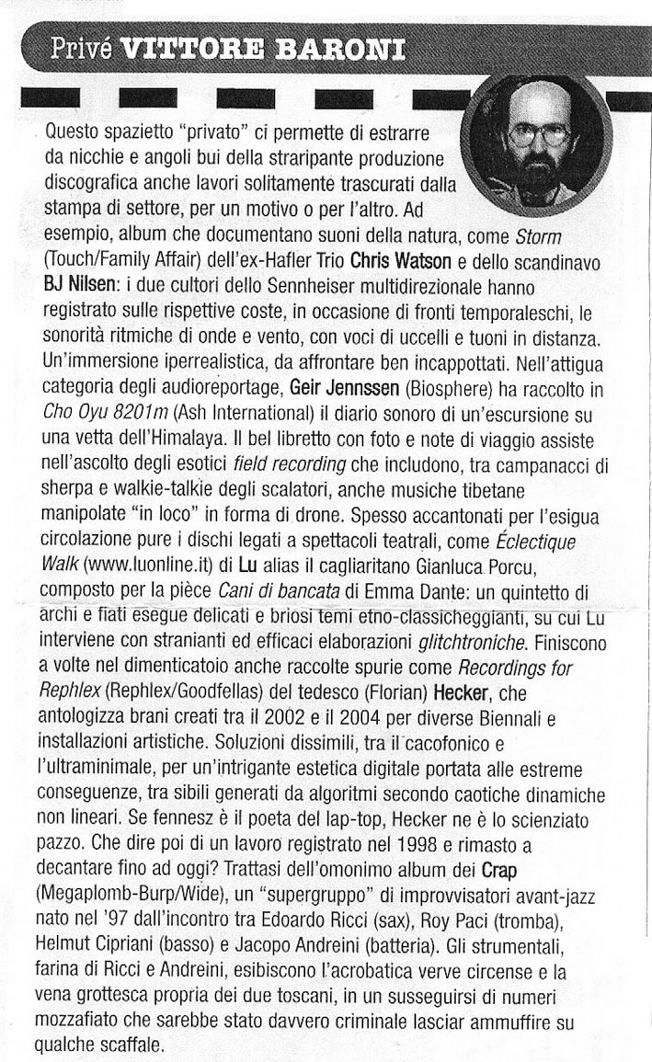
MCD (France):
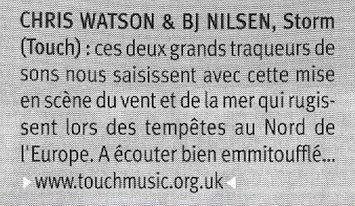
Gonzo Circus (Belgium):
In de zomer van 2000 werden er grote stormen waargenomen aan de kust van Scandinavië en de Noordzee. Het inspireerde Chris Watson en Bj Nilsen om over een periode van vijf jaar op regelmatige tijdstippen opnames te maken aan de kust. Het resultaat van hun monnikenwerk krijgt met de release van ‘Storm’ nu een slotstuk. Voor Chris Watson, ooit actief bij Cabaret Voltaire en nu voltijds medewerker bij de BBC waar hij het geluid bij natuurdocumentaires verzorgd, is het geen nieuw gegeven. Op zijn vroeger plaatwerk horen we een bezielende Watson die geluiden documenteert en die op de eerste plaats vooral een ‘goed luisteraar’ bleek te zijn. Ook voor Bj Nilsen was het geen ongekend terrein. De Zweed maakte in zijn platen en installaties ook al gebruik van field recordings. Watson opent de plaat met een nummer dat hij opbouwde uit verschillende opname die hij maakte op de stranden van Bodly Bay. Het tweede luik ‘SIGWX’ werd door beiden opgenomen in Viking. Nilsen is verantwoordelijke voor het slotnummer dat hij opname op de kust van Gotland en Ötland in Zweden. Watson en Nilsen slagen met ‘Storm’ in hun opzet om een plaat te maken die verder grijpt dan de ‘pure opname’. Verschillende stukken werden minutieus in elkaar gevlochten tot een coherent muziekstuk, waarin wind, regen en water de muziekinstrumenten vormen. ‘Storm’ is een uitgediept stukje natuur, samengesteld door twee fanaten, luisteraars met een uitzonderlijk goed gehoor. Watson en Bj Nilsen weten hoe de wind klinkt. Denk daar maar even over na. Fascinerende neerslag van een stuk natuur. [Peter Deschamps]
Neural (Italy):
Stridulo, inquieto vociare dei gabbiani prima della tempesta, naturali ma allo stesso tempo aliene sequenze sonore, segnali d’un cambiamento climatico significativo, amplificato nella fedele registrazione degli eventi. In ascolto del frangersi delle maree, della pioggia e del vento, c’è Chris Watson, membro dei Cabaret Voltaire e degli Hafler Trio, insieme allo sperimentatore elettronico svedese Bj Nilsen (a sua volta attivo come Hazard e membro degli Janitor). Una coppia di ricercatori che già ricordiamo assieme in ‘Wind’ e poi in ‘Land’, rispettivamente per Ash International e Touch, sempre nel 2001. Anche queste registrazioni risalgono all’incirca a quello stesso periodo e sono state realizzate seguendo diversi fronti tempestosi, sviluppatisi fra il Mare del Nord e la Scandinavia, operando ciascuno su coste differenti, principalmente usando buoni microfoni omnidirezionali. Un opera interessante proprio per le sue qualità ‘immersive’ in ambiti che non è facilmente dato esperire, editata e mixata con tutta la sapienza possibile in studio a Stoccolma cinque anni dopo.
[trans: The shrill, worried seagulls’ clamor before the storm, a natural but at the same time alien sound sequence, a signal of an important climatic change, amplified by the faithful recording of the events. Chris Watson, member of Cabaret Voltaire and Hafler Trio, is listening the tides breaking over the cliffs, the rain and the wind together with Bj Nilsen (aka Hazard and member of Janitor). A couple of researchers that composed also ‘Wind’ and ‘Land’, released by Ash International and Touch in 2001. This is the same period, more or less, of the ‘Storm’ recordings. These were made following different stormy fronts, breaking out in the North Sea and Scandinavia. Each of the two members recorded on different coasts, mainly using good omnidirectional microphones. An interesting work for its own ‘immersive’ quality, related to events that it’s not banal to see live, then edited and mixed in Stockholm, five years after, with the best conceivable mastery.] [Aurelio Cianciotta]
(Denmark):
Det er ofte i samarbejdet med andre, at det mest kunstneriske interessante resultat kan finde sted. Hvor det er beundringsværdigt at udvikle en individuel æstetik, så er det måske endnu mere vanskeligt at lade en individuel vision udfordre af andre og skabe en syntese, der kan bære et værk.
Den svenske lydkunstner B(enny) J(onas) Nilsen synes at have en gave for at involvere sig med andre og skabe æstetiske rum, der er resultatet af mødet med forskellige kunstneriske stemmer, men stadig har det organiske værks aura. På nye samarbejder med henholdsvis islandske Stilluppsteypa og Chris Watson får Nilsen endnu engang skubbet grænserne for hvad man kunne kalde posthuman musik.
Drykkjuvísur Óhljódanna tager udgangspunkt i en arketypisk fristelse: drikfældighedens velsignelser og forbandelser. Sammen med islandske Stilluppsteypa, der består af Sigtrygggur Berg Sigmarsson og Helgi Thorsson, har BJ Nilsen sat sig for at lave et værk, der forvandler det alkoholiske delirium til kolde landskaber af lyd. Dette er på ingen måder drikkeviser i traditionel forstand. Her er ingen ord, ingen løsagtighed eller frivolitet, ingen primitiv manifestering af brovtende maskulinitet eller rå seksualdrift. Drikkeviserne er snarere et filosofisk anliggende, der udspringer af alkoholens paradoks: at den på ene side er en vej ind i forglemmelsen, en flugt fra verden, men at den på den anden side også er en skærpelse af opfattelsen i en slags tåget klarsyn: rusen som et sandhedsserum, der åbner for nye verdener. Drykkjuvísur Óhljódanna er i den forstand ikke et socialt ansvarligt værk, der forsøger at advare om alkoholens alvorlige konsekvenser, men snarere en rapport om en ændring af bevidstheden efter den som en svamp har suget til sig af spiritus (bemærk den etymologiske forbindelse til ordet “ånd”).
Over seks “numre” eller “spor” får vi en stadig mere dyster rejse ind i mørkets hjerte gennem lavmælt susende, knitrende støj og vindblæste landskaber. Der er noget sugende mørkt, men samtidig også eminent sublimt ved disse lyde, der synes renset for menneskelig involvering. Det er som være vidne til en gigantisk åndende organisme. Mest af alt minder det om Islands uendelige udstrakte “levende” landskaber. Den hvide sne er blot erstattet med hvid støj. Der er vanskeligt at tale om en egentlig udvikling af musikken. Netop fordi musikken fremstår uden egentlig begyndelse eller ende, men “blot” er sat i tid, er en fortolkning af musikken fuldstændig åben. Dette svarer godt til kunstnernes intention, som den er beskrevet i pressematerialet: “BJ Nilsen and Stilluppsteypa intend this recording as an open ended experience, wandering through their sound without the burden of any exigetical text that might get in the way.”
Som lytter bliver man befriet for fortolkningens byrde, men det betyder også, at man må nulstille sine forventninger, når det kommer til at finde mening med musikken. Det er høj grad musik, der byder sig til ved sin blotte eksistens, akkurat som et fornemt designermøbel, det er umuligt at sidde i, men som kan beundres på afstand. Sådan er det med BJ Nilsen & Stilluppsteypa sonder af lyd. En stille beruselse uden mål eller mening. Beruselse for beruselsens skyld.
Et lige så fascinerende samarbejde som Drykkjuvísur Óhljódanna er BJ Nilsen kollaboration med Chris Watson på albummet Storm. Filosoffen Immanuel Kant forbandt altid det sublime med ekstraordinære naturfænomener som bjerge og havet, og hertil kunne man også tilføje storme.
Storm starter med en symfoni af fugle, inden regnen og stormen sætter ind. Optagelsen af naturen i dens mest magtfulde vælde er overvældende i sin klarhed. Vi hører havet, som befandt vi os under vandet, stormen suser og fuglene basker lige forbi øret. Kunstnerne siger selv følgende om processen med at optage albummet:
“We spent the next few years gathering recordings on our respective coastlines and islands during the very active weather windows during the autumnal equinox and winter solstice. This was focused around our following one particular cyclonic system, which weers over Snipe Point on Lindisfarne to the Isle of May in the Firth of Forth, and finally descends upon Öland and Gotland where Benny listened in with a favourite pair of Sennheiser omnidirectional microphones.”
Resultat af disse field recordings er intet mindre end fortryllende. Sære lyde af dyr, skvulpende bølger og blæst danner et overdådigt maleri, der er overvældende i sin taktile sensualitet. Som med Drykkjuvísur Óhljódanna er det vanskeligt at finde ud, hvad man skal stille op med sådan et værk andet end blot træde undrende ind i det.
Hvor Drykkjuvísur Óhljódanna nærmer sig det sublime gennem monotoniens glaciale forskydninger af fine lag af støj, blæser Storm bogstaveligt lytteren ind i en anden verden. I begge “værker” er der tale om, at kunstnerne træder tilbage og i stedet lader lyden tale uden om genkendelige musikalske koncepter som melodi, harmoni og rytme. Det er posthuman musik, der er fremragende iscenesat. Det er bestemt ikke for alle og enhver, men har man først fundet ind i disse værker er det særdeles fascinerende lytning.
Som et appendiks bør det det nævnes, at Drykkjuvísur Óhljódanna kun udkommer i et oplag af tusind eksemplarer. Lyttere med interesse for denne udgivelse må derfor nok hellere sikre sig den før end senere. [Jakob Bækgaard]
Touching Extremes (Italy):
This CD is the result of six years of recordings that Watson and Nilsen made on the coastlines of North Sea and Scandinavia in order to satisfy their “mutual interests in the rhythms and music created when the elements combine over land and out to sea”. The wind’s strength, the heavy rain, the impressive roar of the billows (which becomes even scarier when one reads Nilsen’s notes about his “Austrvegr” track) are obviously the most striking elements of the disc, being alternated with different environmental situations such as a sea cave where Watson recorded a segment of “No man’s land”, a place where what he calls “siren songs” often sounds like a walrus in heat. I must admit that I’m partial to this kind of audio documentary, as both sea and wind have been an important part of my development and I perceive their voices as utterly familiar. But the high-quality recording standards which these artists have grown us accustomed to make sure that “Storm” is a compelling album for just anyone who owns the “inner ear” that renders the shrieks of a seagull, the gurgling of water and the rumble of a thunder all symbols of that undeterred resolution allowing us to resist in the worst moments of our existence. A storm can make you feel like counting for nothing, but its astonishing effects on the psyche remain wonderful. [Massimo Ricci]
Buzz (UK):

GoMag (Spain):
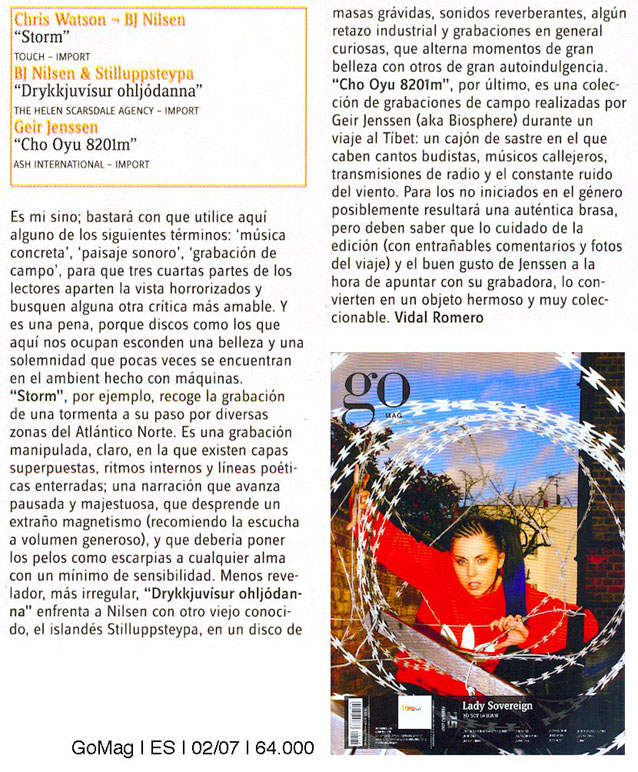
Earplug (UK):
Nature is not your mother. Nature will swallow you and spit you out in meaty chunks, because that’s the nature of Nature. Inspired by a shared fascination with the violent storms that raged in December 2000, phonographers Watson (Cabaret Voltaire) and Nilsen (Hazard) spent five years using their impressive arsenal of recording equipment to capture moments of climactic tension that approach the cinematic. Birds mass in anticipation of storms, cries fading gently into lapping ocean noise and back again; stark sounds float amid the waves that precede the calm-crushing tempest. The sounds on Storm may seem otherworldly, but that’s because they’re presented with such unusual immediacy. (DMC)
Gonzo Circus (Belgium):
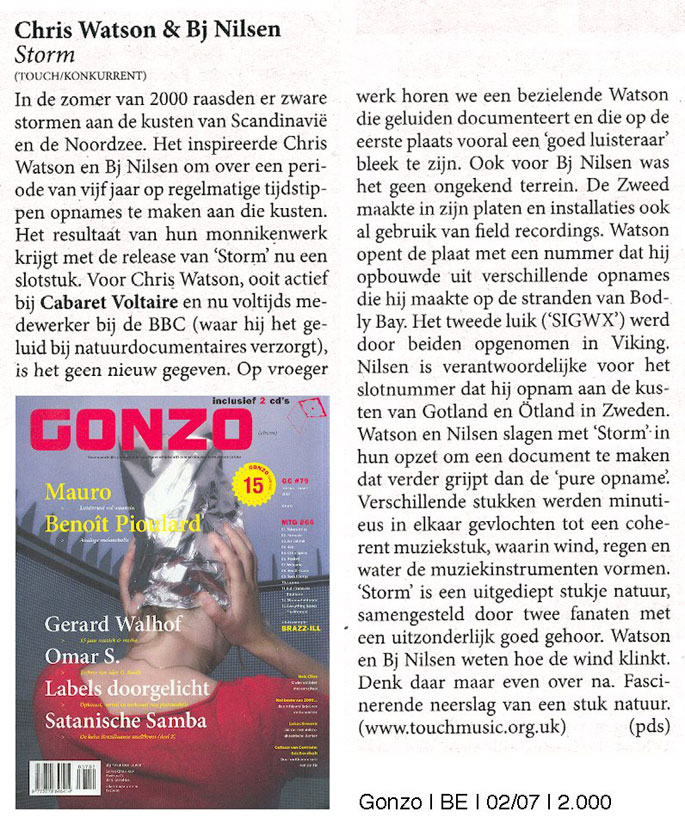
XLR8R (USA):
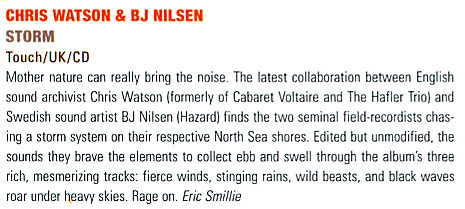
Nordische Musik (Germany):
Sehr passend zu den heftigen Januarstürmen, die wir hier in Deutschland erlebt haben: »STORM«. Die Idee zu diesem Album entstand, als Benny Nilsen im Dezember 2000 einige Tonaufnahmen gemacht hatte von heftigen Stürmen, die über die Nordsee und Skandinavien hinweggefegt waren. Er und Chris Watson sammelten in der Folgezeit weiteres Material, zum Beispiel im Nordosten von England und Schottland oder an den Südostküsten von Gotland und Öland.
Daraus mischten sie drei jeweils viertelstündige »Hörspiele«, die zugegebenermaßen Geduld erfordern. Bringt man sie auf, so kann man tief eintauchen in diese akustischen Naturtapeten, die doch so überhaupt nicht taugen als klingendes Möbel. Vielmehr ergeht es einem so wie Blinden, die mehr zu hören in der Lage sind als das offensichtlich Hörbare. Man erkennt plötzlich fein abgestufte Nuancen und nimmt das Spektakel als komponierte Aufführung war (die sie im Grunde durch die Nachbearbeitung ja auch ist). Kopfhörer erleichtern den Ausflug in das Auge des Sturms, und dann fehlt nicht mehr viel, um das zu empfinden, was BJ Nilsen zu den Aufnahmebedingungen des Stücks »Austrvegr« schreibt: »A black ruthless sea. Heavy winds making it impossible to stand up straight, icy rain hitting your face like needles«. [peb]
Cyclic Defrost (USA):
Promulgating that figs don’t grow on thistles, one may look upon nature as something of a primordial mother, as something we grew out of rather than were born into. If it tickles one’s fancy, one might see the oceans as God’s tears – hence our desire to drown in them, as a short-cut to God through his tears. With Storm, sound archivist Chris Watson and experimental electronica musician BJ Nilsen forge a certain perspective and approach to nature, recording a series of large storms as they developed across the North Sea and Scandinavia during December of 2000.
These pieces offer a depiction of nature which is neither as mystical nor as motherly as the two aforementioned stories. Rather, the raw carnal force of nature and its ability to rupture the course of events with consummate indifference is paid close, careful attention. On ‘No Man’s Land’, in particular, this frenetic element in nature is not only manifested, but it is pushed into overdrive, volatized, and perfected by Watson’s editing and mixing prowess. Stitched together from a smattering of recordings captured along the North Sea over the course of five years, the thin, high-pitched and often tortured voices of an assortment of sea animals bristle with electricity and unease. Each new tidal surge of waves, scouring winds and squawking seagulls breaks the continuity of things and seems unreal, yet they make their entrance with stupefying ease. Nilsen’s piece, meanwhile, stands on the opposite side of the spectrum, sounding almost archaic as it opts for a trajectory which gives the work a very real sense of time and place.
At an hours length, the final track is a collage of sounds gathered from each of the artists respective geographical locations. As a result of the processing involved, the track dithers between the real and the imaginary – oscillating between representing particular events in stark clarity to tweaking and shrouding the details. The effect has something of the uncanny about it – all of the elements are familiar enough and can be traced back to tangible origins, yet arranged as they are, the whole appears foreign, peculiar; too theatrical to be real, yet plainly there. [Max Schaefer]
Signal to Noise (USA):

His Voice (Czechia):
Sound of Music (Sweden):
Att spela in ljud är en av mina äldsta drömmar. Samla på naturens musik, stadsbuller och allt däremellan. Någon gång ska det projektet ta fart. Och med ett ökat intresse de senaste åren för skivor med fältinspelningar kan man sitta hemma i fåtöljen och lyssna på ljud från vitt skilda miljöer. Ibland blir det lättköpt när musiker som knep för att skapa en speciell stämning bakar in fågelkvitter, avlägsna röster och andra ickemusikaliska inslag. Men ofta tycker jag att det tillför någonting, det finns så många intressanta ljud, så mycket musik i tingen.
I en Invisible Jukebox-intervju i The Wire för något år sedan uttryckte Chris Watson (en gång i tiden medlem i Cabaret Voltaire) stark skepsis mot musiker och artister som jobbar på det här sättet. Han är bara intresserad av rena naturljud. Hårda ord kan tyckas, men om man lyssnar på Chris Watsons album med fältinspelningar på Touch är det lätt att förstå åsikten. Det är fantastiska skivor. Nedslag på olika platser, många i samband med BBC-produktioner, med en strävan att verkligen fånga en plats, en händelse, från naturens mångskiftande värld.
De rena, naturliga, ljuden rymmer myriader av färger, stämningar. I de tre långa spåren på Chris Watsons förra skiva, ”Weather Report”, kommer ett begrepp som kompositioner in i bilden. Parallellerna med skapade musikstycken är tydlig. Samma känsla får jag av ”No Man´s Land” som inleder Chris Watson och BJ Nilsens skiva ”Storm”. Inspelningar från Storbritanniens nordöstra kust höstmånaderna oktober och november 2000 –2005 som klippts ihop. Detsamma gäller Nilsens bidrag ”Austrvegr” (inspelningar från Gotland och Öland) och ett tredje gemensamt stycke. Arbetet startade med att Nilsen spelade in stormar och föreslog ett gemensamt cd-projekt ”based around our mutual interests in the rhythms and music created when the elements combine over land and out to sea”, som Watson skriver på konvolutet.
Ingenmansland. Sjöfåglarnas rike. Vinden stegrar. Vattnet attackerar klipporna. Mikrofonerna närmar sig skummet, rytmerna i vattnets möte med det annalkande ovädret är i ständig förändring. Uppstigande och nedstigande, det är en fysisk upplevelse att lyssna. Efter nio minuter ungefär är det en annan akustik, ett kort tag låter det som man har hamnat i en undervattensgrotta. Fnys-, pip- och knorrljud tar vid. Frustande sälar? Valross? Eller stora fåglar. En albatrossfamilj? Det blåser mer och mer. Sjöfåglarna återkommer, cirkelrörelser, jag kan knappt simma, rädslan, respekten för havet. Strandområden. Klipporna. Människans frånvaro. Chris Watsons mikrofoner registrerar, dokumenterar, berättar. Ickemusik som är musik.
BJ Nilsens stormkomposition förflyttar oss till Östersjön. Jag fryser när jag skriver. Jag fryser när jag lyssnar. Mycket avlägsna fåglar vid något tillfälle. Vinden och vattnet i ett mäktigt samspel. Samtidigt vill jag vara där, stå i varma kläder och lyssna på rytmerna. Är det natt? Det känns så. Åtminstone när det blåser hårt och skoningslöst. Vattenskvalpet en bit efter mitten har en mer melodisk klang. En lugnande effekt. Senare ljud studsar mot föremål. Trädgrenar kanske, något fladdrar, inspelat i ett tält? Rinnande vatten nära mikrofonerna. Små och stora element.
Det gemensamma stycket startar med djur(?)läten. Långsamma, fuktiga yl. Vattnet närmar sig och är i centrum.Inte lika mycket vindljud. Steg mot sanden, mellanrummet. Zonen innan och efter havet. Det regnar igen. Spikar. Kalla nålar. Tjocka partiklar. Det ökar och ökar och ökar. Flera nivåer av ljud. Många detaljer. En tyst rytm, komprimerat, fåglar.
Chris Watson och BJ Nilsen använder mikrofoner som sina instrument. Det är en överväldigande ljudupplevelse. Naturens enorma krafter i en renande symfoni. [Magnus Olsson]
Neural (Italy):
The shrill, worried seagulls’ clamor before the storm, a natural but at the same time alien sound sequence, a signal of an important climatic change, amplified by the faithful recording of the events. Chris Watson, member of Cabaret Voltaire and Hafler Trio, is listening the tides breaking over the cliffs, the rain and the wind together with BJNilsen (aka Hazard and member of Janitor). A couple of researchers that composed also ‘Wind’ and ‘Land’, released by Ash International and Touch in 2001. This is the same period, more or less, of the ‘Storm’ recordings. These were made following different stormy fronts, breaking out in the North Sea and Scandinavia. Each of the two members recorded on different coasts, mainly using good omnidirectional microphones. An interesting work for its own ‘immersive’ quality, related to events that it’s not banal to see live, then edited and mixed in Stockholm, five years after, with the best conceivable mastery. [Aurelio Cianciotta]
Bant (Turkey):
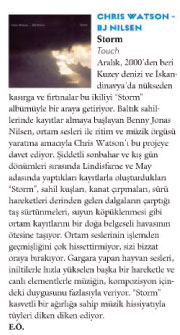
ideabiografica (Italy):
Decisamente è – ormai – da qualche anno che ascolto musica e scrivo di essa, ma – fino ad ora – non mi era mai capitato di “sentire” ciò che ora vi descriverò. Ghiaccio, diamante freddo allo stato puro… La label imputata alla pubblicazione di questi cd “bianchi” si chiama Touch e ha sede in quel di Londra. Ma con la pop music, la dance ed il rock non c’entra proprio nulla. La Touch impone una sua personale interpretazione (e naturale visione) dell’arte. Questa “personalissima” (e cruda) “interpretazione” si sviluppa in lavori veramente stranianti. Ad esempio Chris Watson (britannico di Sheffield, e nessuna parentela con la scena elettronica dei Cabaret Voltaire ect.) e Bj Nilsen (svedese) hanno letteralmente creato dal nulla “Storm”. “Tempesta” nella traduzione in italiano, cioè hanno registrato gli sconvolgimenti della natura nel mare del Nord. Tutto in stereofonia, così si potranno ascoltare il debordare delle acque e le “grida” degli uccelli. Opera totalmente avulsa da qualsiasi concetto commerciale. Come “Jessamine” a firma della neo zelandese Rosy Parlane, in cui rumori o “drones” urticanti scavano nel profondo della mente. Melodia ovviamente zero, tabula rasa desertificata. Rosy spezzetta vorticosamente tutto quello che si potrebbe definire suono, e castra ogni possibilità dell’arrivo di semplici note. Sarà che sto vertiginosamente invecchiando, però questi lapilli di “cultura” mi hanno catturato il cervello. Tutto molto bello come il capodanno dell’anno 2007, solitario, in preda alle onde marine e a scricchiolii circospetti… [Claudio Baroni]











